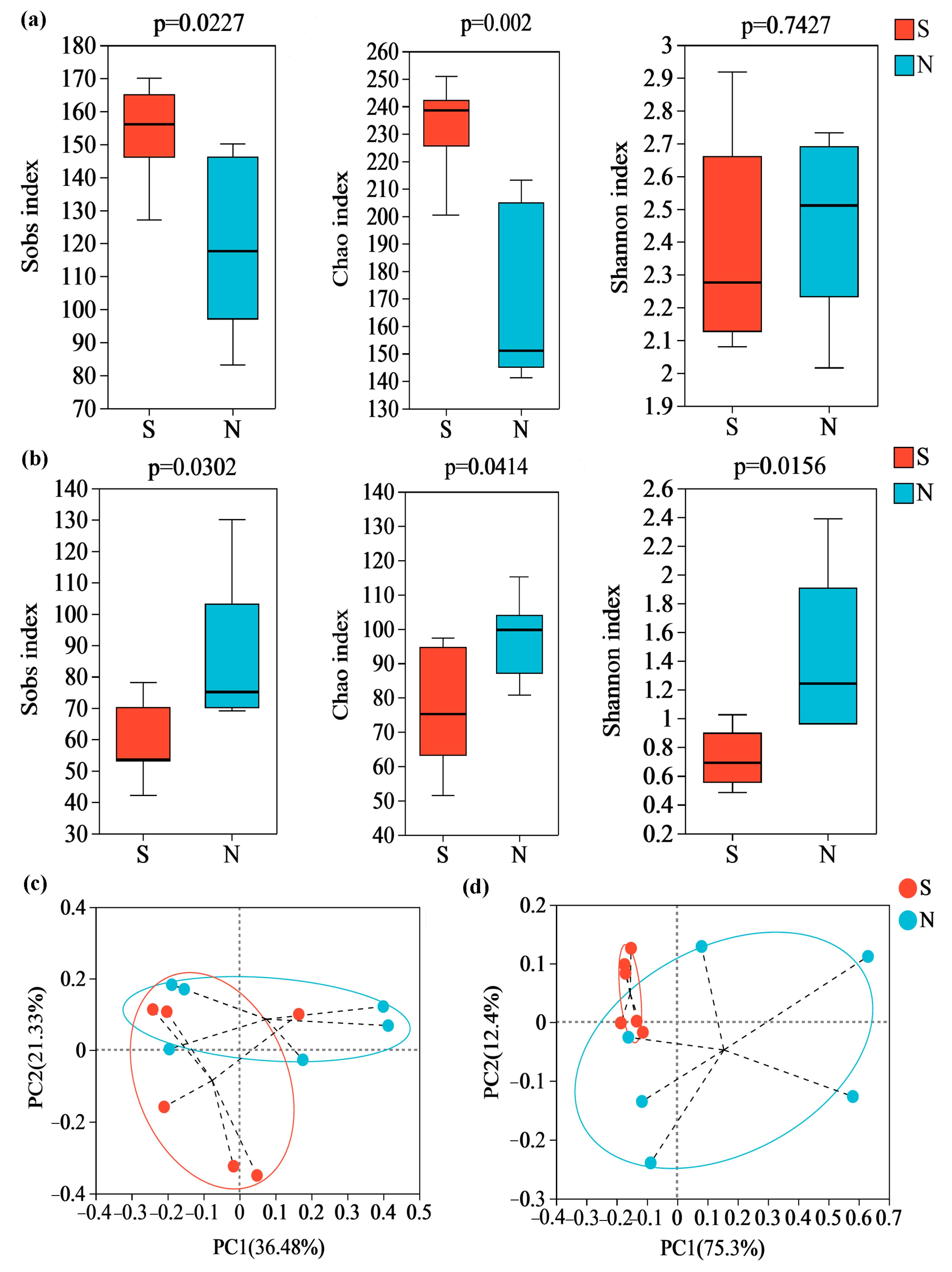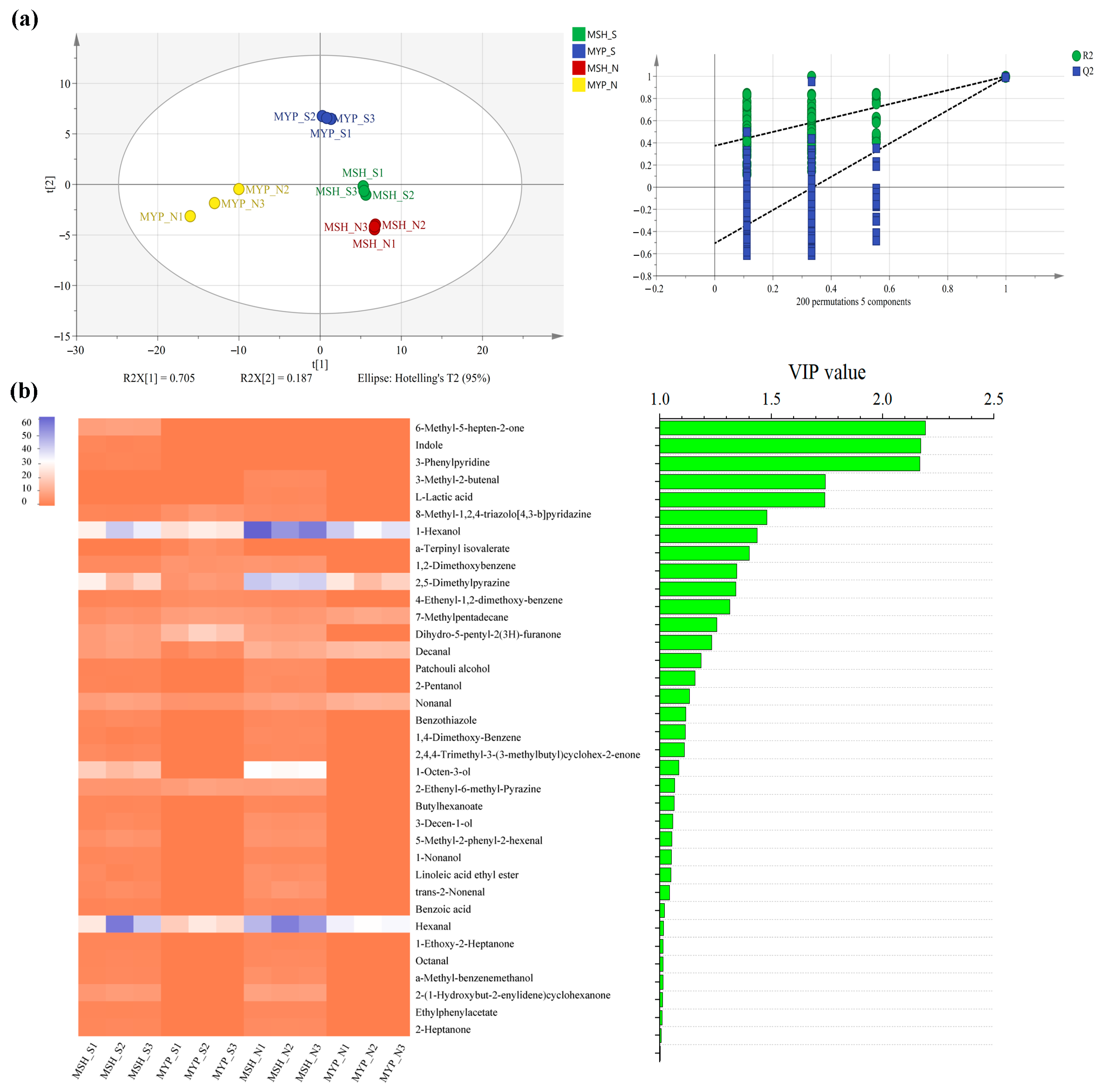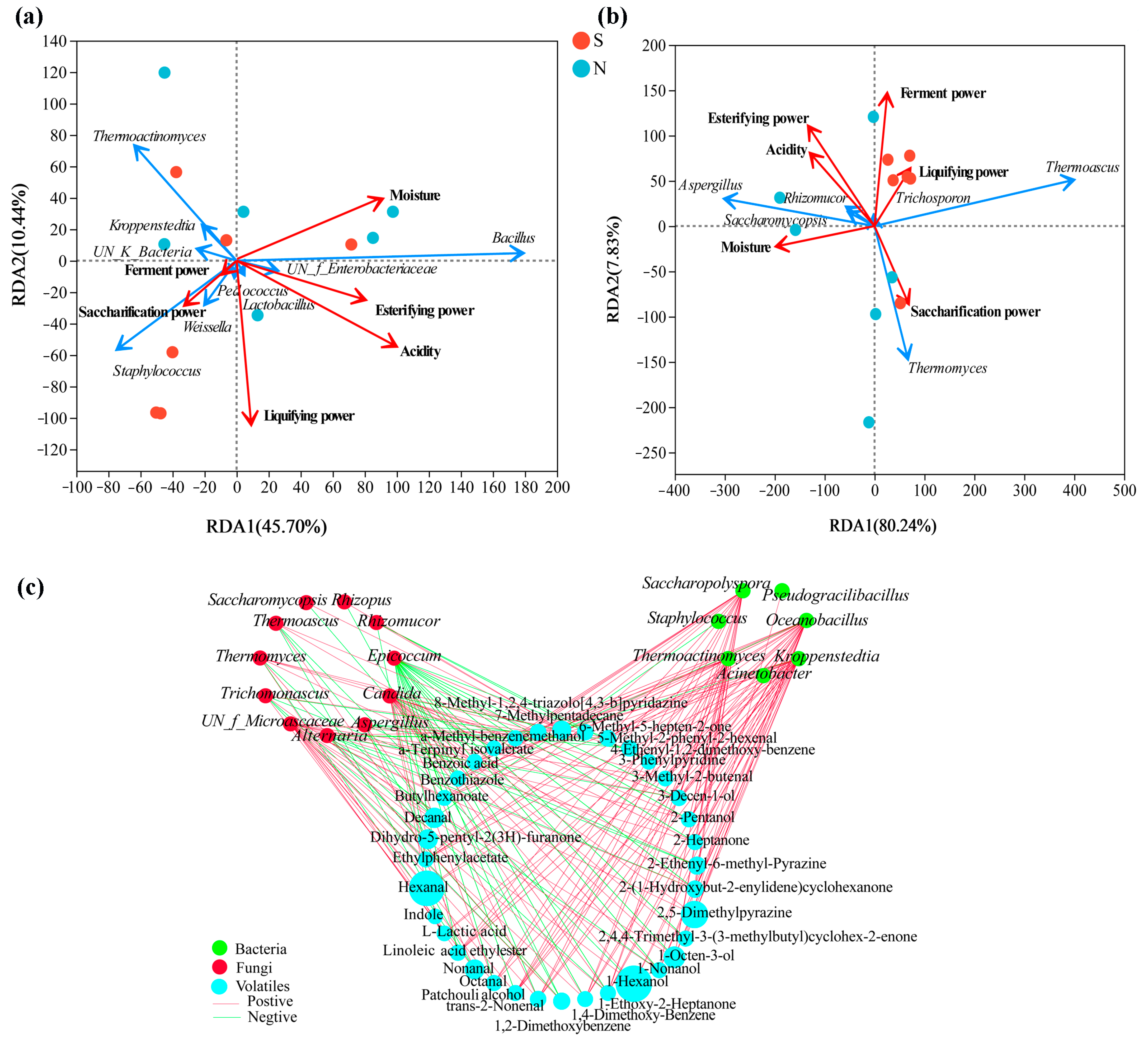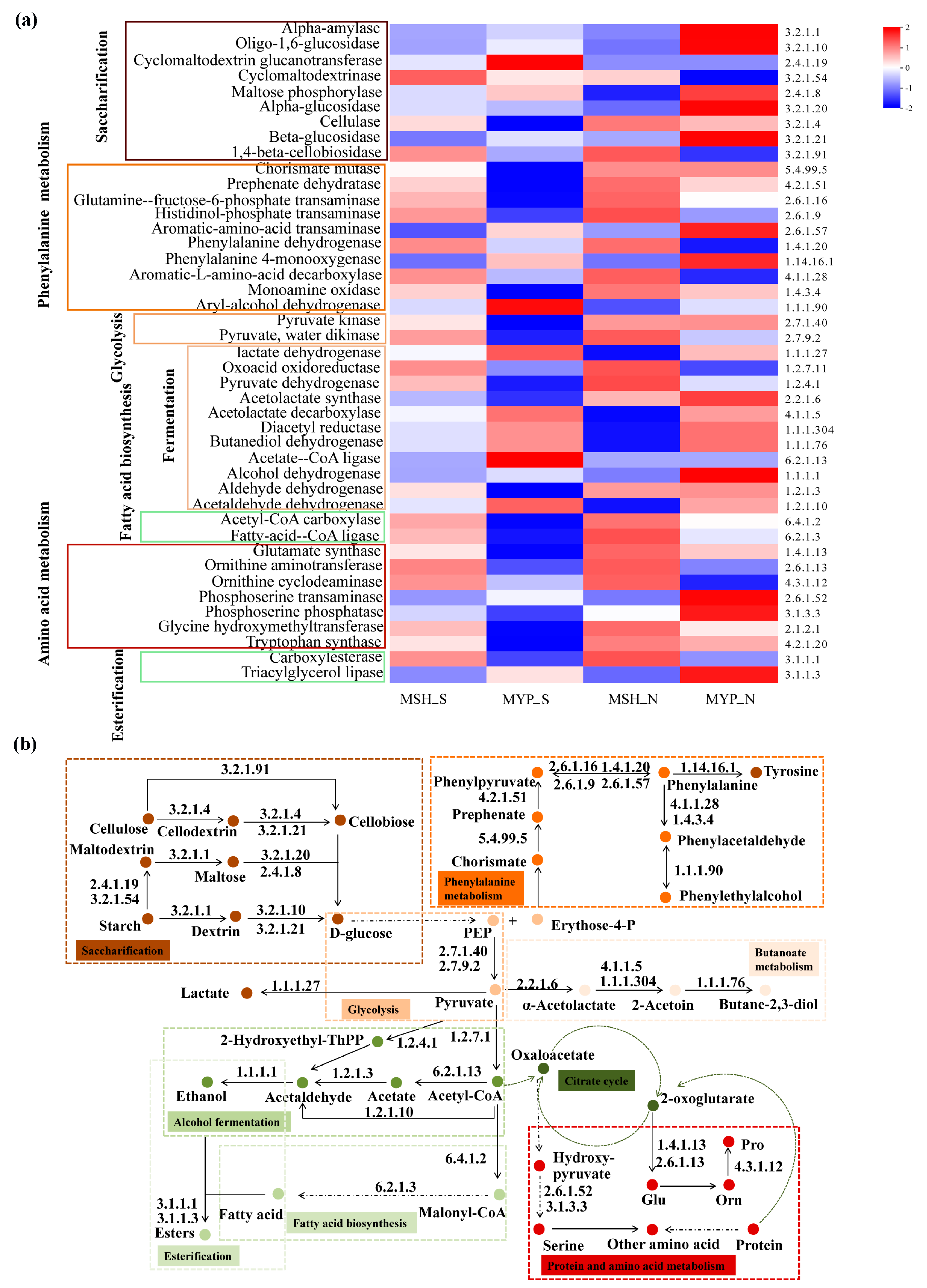Differential Characteristics of the Metabolic Profiles and Microbial Community between Superior and Normal Grades of Nongxiangxing-daqu
Abstract
1. Introduction
2. Materials and Methods
2.1. Daqu Quality Evaluating and Sampling
2.2. Culture-Dependent Microbial Counts
2.3. Determination of Physiochemical Properties
2.4. Analysis of Volatile Compounds
2.5. DNA Extraction and Amplicon High-Throughput Sequencing
2.6. Bioinformatics and Statistical Analysis
3. Results
3.1. Cultivable Microbial Counts of NXDQ Samples
3.2. Comparison of Physicochemical Properties
3.3. Microbial Community α-Diversity and β-Diversity between S- and N-NXDQ
3.4. Microbial Community Composition and Difference between S- and N-NXDQ
3.5. Volatile Compounds Composition
3.6. Dominant Microbial Relationships with the Physicochemical Properties and the Differential Volatile Compounds
3.7. Potential Function Prediction and Metabolic Pathways of the Microbial Communities in S- and N-NXDQ
4. Discussion
5. Conclusions
Supplementary Materials
Author Contributions
Funding
Institutional Review Board Statement
Informed Consent Statement
Data Availability Statement
Acknowledgments
Conflicts of Interest
References
- Liu, H.; Sun, B. Effect of Fermentation Processing on the Flavor of Baijiu. J. Agric. Food Chem. 2018, 66, 5425–5432. [Google Scholar] [CrossRef]
- Ma, S.; Shang, Z.; Chen, J.; Shen, Y.; Li, Z.; Huang, D.; Luo, H. Differences in structure, volatile metabolites, and functions of microbial communities in Nongxiangxing daqu from different production areas. LWT 2022, 166, 113784. [Google Scholar] [CrossRef]
- Liu, Y.; Li, H.; Dong, S.; Zhou, Z.; Zhang, Z.; Huang, R.; Han, S.; Hou, J.; Pan, C. Dynamic changes and correlations of microbial communities, physicochemical properties, and volatile metabolites during Daqu fermentation of Taorong-type Baijiu. LWT 2023, 173, 114290. [Google Scholar] [CrossRef]
- Liu, J.; Chen, J.; Fan, Y.; Huang, X.; Han, B. Biochemical characterisation and dominance of different hydrolases in different types of Daqu—A Chinese industrial fermentation starter. J. Sci. Food Agric. 2018, 98, 113–121. [Google Scholar] [CrossRef] [PubMed]
- Hou, X.; Hui, M.; Sun, Z.; Li, X.; Shi, X.; Xiao, R.; Wang, J.; Pan, C.; Li, R. Comparative analysis of the microbiotas and physicochemical properties inside and outside medium-temperature Daqu during the fermentation and storage. Front. Microbiol. 2022, 13, 934696. [Google Scholar] [CrossRef] [PubMed]
- Fan, G.; Fu, Z.; Teng, C.; Wu, Q.; Liu, P.; Yang, R.; Minhazul, K.H.M.; Li, X. Comprehensive analysis of different grades of roasted-sesame-like flavored Daqu. Int. J. Food Prop. 2019, 22, 1205–1222. [Google Scholar] [CrossRef]
- Hou, X.; Hui, M.; Sun, Z.; Li, X.; Shi, X.; Xiao, R.; Wang, J.; Pan, L.; Pan, C.; Li, R. Associations between wheat varieties and the functional microbial community of Nongxiangxing daqu from northern China. LWT 2023, 185, 115119. [Google Scholar] [CrossRef]
- Wu, S.; Du, H.; Xu, Y. Daqu microbiota adaptability to altered temperature determines the formation of characteristic compounds. Int. J. Food Microbiol. 2023, 385, 109995. [Google Scholar] [CrossRef]
- Zeng, H.; Jiang, X.; Wang, Z.; Zeng, X.; Xin, B.; Wang, Y.; Zhang, X.; Yang, H.; Qiao, J.; Dong, R.; et al. Environmental and Physicochemical Characterization and Fungal Community of Two Batches of Chinese Luzhou-Flavored Daqu. J. Am. Soc. Brew. Chem. 2021, 81, 190–197. [Google Scholar] [CrossRef]
- Zhu, Q.; Chen, L.; Peng, Z.; Zhang, Q.; Huang, W.; Yang, F.; Du, G.; Zhang, J.; Wang, L. Analysis of environmental driving factors on Core Functional Community during Daqu fermentation. Food Res. Int. 2022, 157, 111286. [Google Scholar] [CrossRef]
- Tang, J.; Rao, J.; Zou, Y.; Liao, L.; Huang, D.; Luo, H. The community assembly patterns determined differences between the surface and the core microbial communities of Nongxiangxing Daqu. LWT 2023, 183, 114936. [Google Scholar] [CrossRef]
- Wang, Y.; Cai, W.; Wang, W.; Shu, N.; Zhang, Z.; Hou, Q.; Shan, C.; Guo, Z. Analysis of microbial diversity and functional differences in different types of high-temperature Daqu. Food Sci. Nutr. 2020, 9, 1003–1016. [Google Scholar] [CrossRef]
- Zhang, Y.; Ding, F.; Shen, Y.; Cheng, W.; Xue, Y.; Han, B.-Z.; Chen, X. Characteristics of the microbiota and metabolic profile of high-temperature Daqu with different grades. World J. Microb. Biot. 2022, 38, 137. [Google Scholar] [CrossRef]
- Hu, Y.; Huang, X.; Yang, B.; Zhang, X.; Han, Y.; Chen, X.-X.; Han, B.-Z. Contrasting the microbial community and metabolic profile of three types of light-flavor Daqu. Food Biosci. 2021, 44, 101395. [Google Scholar] [CrossRef]
- Shi, W.; Chai, L.-J.; Fang, G.-Y.; Mei, J.-L.; Lu, Z.-M.; Zhang, X.-J.; Xiao, C.; Wang, S.-T.; Shen, C.-H.; Shi, J.-S.; et al. Spatial heterogeneity of the microbiome and metabolome profiles of high-temperature Daqu in the same workshop. Food Res. Int. 2022, 156, 111298. [Google Scholar] [CrossRef]
- Deng, L.; Mao, X.; Liu, D.; Ning, X.-Q.; Shen, Y.; Chen, B.; Nie, H.-F.; Huang, D.; Luo, H.-B. Comparative Analysis of Physicochemical Properties and Microbial Composition in High-Temperature Daqu with Different Colors. Front. Microbiol. 2020, 11, 588117. [Google Scholar] [CrossRef]
- Gan, S.-H.; Yang, F.; Sahu, S.K.; Luo, R.-Y.; Liao, S.-L.; Wang, H.-Y.; Jin, T.; Wang, L.; Zhang, P.-F.; Liu, X.; et al. Deciphering the Composition and Functional Profile of the Microbial Communities in Chinese Moutai Liquor Starters. Front. Microbiol. 2019, 10, 01540. [Google Scholar] [CrossRef] [PubMed]
- QB/T 4259-2011; People’s Republic of China Light Industry Professional Standard: Strong Flavour Daqu. Ministry of Industry and Information Technology of the People’s Republic of China: Beijing, China, 2011.
- Xu, B.; Xu, S.; Cai, J.; Sun, W.; Mu, D.; Wu, X.; Li, X. Analysis of the microbial community and the metabolic profile in medium-temperature Daqu after inoculation with Bacillus licheniformis and Bacillus velezensis. LWT 2022, 160, 113214. [Google Scholar] [CrossRef]
- Chevallier, S.; Bertrand, D.; Kohler, A.; Courcoux, P. Application of PLS-DA in multivariate image analysis. J. Chemom. 2006, 20, 221–229. [Google Scholar] [CrossRef]
- Magoč, T.; Salzberg, S. FLASH: Fast length adjustment of short reads to improve genome assemblies. Bioinformatics 2011, 27, 2957–2963. [Google Scholar] [CrossRef] [PubMed]
- Schloss, P.; Gevers, D.; Westcott, S. Reducing the effects of PCR amplification and Sequencing artifacts on 16S rRNA-based studies. PLoS ONE 2011, 6, e27310. [Google Scholar] [CrossRef]
- Segata, N.; Izard, J.; Waldron, L.; Gevers, D.; Miropolsky, L.; Garrett, W.S.; Huttenhower, C. Metagenomic biomarker discovery and explanation. Genome Biol. 2011, 12, 60. [Google Scholar] [CrossRef] [PubMed]
- Douglas, G.M.; Maffei, V.J.; Zaneveld, J.; Yurgel, S.N.; Brown, J.R.; Taylor, C.M.; Huttenhower, C.; Langille, M.G.I. PICRUSt2 for prediction of metagenome functions. Nat. Biotechnol. 2020, 38, 685–688. [Google Scholar] [CrossRef] [PubMed]
- Makarenkov, V.; Legendre, P. Nonlinear redundancy analysis and canonical correspondence analysis based on polynomial regression. Ecology 2022, 83, 1146–1161. [Google Scholar] [CrossRef]
- Zhang, Y.; Shen, Y.; Niu, J.; Ding, F.; Ren, Y.; Chen, X.; Han, B.Z. Bacteria-induced amino acid metabolism involved in appearance characteristics of high-temperature Daqu. J. Sci. Food Agric. 2022, 103, 243–254. [Google Scholar] [CrossRef] [PubMed]
- Zhu, M.; Zheng, J.; Xie, J.; Zhao, D.; Qiao, Z.-W.; Huang, D.; Luo, H.-B. Effects of environmental factors on the microbial community changes during medium-high temperature Daqu manufacturing. Food Res. Int. 2022, 153, 110955. [Google Scholar] [CrossRef]
- Ma, S.; Luo, H.; Zhao, D.; Qiao, Z.; Zheng, J.; An, M.; Huang, D. Environmental factors and interactions among microorganisms drive microbial community succession during fermentation of Nongxiangxing daqu. Bioresour. Technol. 2022, 345, 126549. [Google Scholar] [CrossRef] [PubMed]
- Shyam Prasad, G.; Girisham, S.; Reddy, S.M. Potential of Thermophilic fungus Rhizomucor pusillus NRRL 28626 in biotransformation of antihelmintic drug albendazole. Appl. Biochem. Biotech. 2011, 165, 1120–1128. [Google Scholar] [CrossRef]
- Mao, J.; Liu, X.; Gao, T.; Gu, S.; Wu, Y.; Zhao, L.; Ma, J.; Li, X.; Zhang, J. Unraveling the correlations between bacterial diversity, physicochemical properties and bacterial community succession during the fermentation of traditional Chinese strong-flavor Daqu. LWT 2022, 154, 112764. [Google Scholar] [CrossRef]
- Fu, G.; Cai, W.; Dong, B.; Wan, Y.; Pan, F.; Zheng, F.; Chen, Y.; Deng, M.; Huang, B. Effects of bio-augmented Daqu on microbial community, aroma compounds and physicochemical parameters of fermented grains during the brewing of Chinese special-flavor baijiu. J. Sci. Food Agric. 2022, 103, 273–282. [Google Scholar] [CrossRef]
- He, M.; Jin, Y.; Zhou, R.; Zhao, D.; Zheng, J.; Wu, C. Dynamic succession of microbial community in Nongxiangxing daqu and microbial roles involved in flavor formation. Food Res. Int. 2022, 159, 111559. [Google Scholar] [CrossRef]
- Zhao, Q.-S.; Yang, J.-G.; Zhang, K.-Z.; Wang, M.-Y.; Zhao, X.-X.; Su, C.; Cao, X.-Z. Lactic acid bacteria in the brewing of traditional Daqu liquor. J. Inst. Brew. 2020, 126, 14–23. [Google Scholar] [CrossRef]
- Fan, W.L.; Qian, M.C. Characterization of aroma components of Chinese “Wuliangye” and “Jiannanchuan” liquors by aroma extracr dilution analysis. J. Agric. Food Chem. 2006, 54, 2695–2704. [Google Scholar] [CrossRef]
- Hu, Y.; Yang, Q.; Chen, D.; Fu, B.; Zhang, Y.; Zhang, Y.; Xia, X.; Peng, N.; Liang, Y.; Zhao, S. Study on microbial communities and higher alcohol formations in the fermentation of Chinese Xiaoqu Baijiu produced by traditional and new mechanical technologies. Food Res. Int. 2021, 140, 109876. [Google Scholar] [CrossRef] [PubMed]
- Xi, X.; Yang, F.; Chen, L.; Lu, J.; Wang, L. Dynamic changes of bacteria communities in Moutai-flavour Daqu during storage analysed by next generation sequencing. Lett. Appl. Microbiol. 2022, 75, 1486–1496. [Google Scholar] [CrossRef] [PubMed]
- Li, P.; Lin, W.; Liu, X.; Wang, X.; Gan, X.; Luo, L.; Lin, W.-T. Effect of bioaugmented inoculation on microbiota dynamics during solid-state fermentation of Daqu starter using autochthonous of Bacillus, Pediococcus, Wickerhamomyces and Saccharomycopsis. Food Microbiol. 2017, 61, 83–92. [Google Scholar] [CrossRef] [PubMed]
- Wang, P.; Wu, Q.; Jiang, X.; Wang, Z.; Tang, J.; Xu, Y. Bacillus licheniformis affects the microbial community and metabolic profile in the spontaneous fermentation of Daqu starter for Chinese liquor making. Int. J. Food Microbiol. 2017, 250, 59–67. [Google Scholar] [CrossRef]
- Zhang, C.; Ao, Z.; Chui, W.; Shen, C.; Tao, W.; Zhang, S. Characterization of the aroma-active compounds in Daqu: A tradition Chinese liquor starter. Eur. Food Res. Technol. 2011, 234, 69–76. [Google Scholar] [CrossRef]
- Wang, X.; Ban, S.; Hu, B.; Qiu, S.; Zhou, H. Bacterial diversity of Moutai-flavour Daqu based on high-throughput sequencing method. J. Inst. Brew. 2017, 123, 138–143. [Google Scholar] [CrossRef]
- Wang, X.-D.; Ban, S.-D.; Qiu, S.-Y. Analysis of the mould microbiome and exogenous enzyme production in Moutai-flavor Daqu. J. Inst. Brew. 2018, 124, 91–99. [Google Scholar] [CrossRef]
- Dadzie, M.; Oppong, A.; Ofori, K.; Eleblu, J.; Ifie, E.; Blay, E.; Obeng–Bio, E.; Appiah-Kubi, Z.; Warburton, M. Distribution of Aspergillus flavus and aflatoxin accumulation in stored maize grains across three agro-ecologies in Ghana. Food Control 2019, 104, 91–98. [Google Scholar] [CrossRef]
- Luo, S.; Zhang, Q.; Yang, F.; Lu, J.; Peng, Z.; Pu, X.; Zhang, J.; Wang, L. Analysis of the Formation of Sauce-Flavored Daqu Using Non-targeted Metabolomics. Front. Microbiol. 2022, 13, 857966. [Google Scholar] [CrossRef] [PubMed]
- Zuo, Q.; Huang, Y. MinGuo, Evaluation of bacterial diversity during fermentation process: A comparison between handmade and machine-made high-temperature Daqu of Maotai-flavor liquor. Ann. Microbiol. 2020, 70, 57. [Google Scholar] [CrossRef]
- Jin, Y.; Li, D.; Ai, M.; Tang, Q.; Huang, J.; Ding, X.; Wu, C.; Zhou, R. Correlation between volatile profiles and microbial communities: A metabonomic approach to study Jiang-flavor liquor Daqu. Food Res. Int. 2019, 121, 422–432. [Google Scholar] [CrossRef] [PubMed]









| NXDQ | Sample | Moisture (%) | Acidity (mmol/10 g) | Liquifying Power (g/g·h) | Saccharification Power (mg/g·h) | Esterifying Power (mg/g·100 h) | Ferment Power (gCO2/g·72 h) |
|---|---|---|---|---|---|---|---|
| S-NXDQ | MSH_S | 11.30 ± 0.49 c | 0.60 ± 0.07 c | 2.34 ± 0.06 c | 366.00 ± 50.91 c | 27.74 ± 1.73 b | 0.49 ± 0.01 a |
| MYP_S | 11.80 ± 0.07 c | 1.70 ± 0.02 b | 3.85 ± 0.11 a | 519.00 ± 10.61 a | 25.71 ± 5.00 b | 0.30 ± 0.04 b | |
| N-NXDQ | MSH_N | 12.27 ± 0.52 b | 0.58 ± 0.03 c | 2.26 ± 0.01 c | 462.00 ± 72.00 ab | 22.56 ± 4.54 bc | 0.25 ± 0.08 b |
| MYP_N | 13.33 ± 0.88 a | 2.15 ± 0.56 a | 2.65 ± 0.07 b | 375.00 ± 72.12 c | 33.64 ± 0.31 a | 0.33 ± 0.02 b |
Disclaimer/Publisher’s Note: The statements, opinions and data contained in all publications are solely those of the individual author(s) and contributor(s) and not of MDPI and/or the editor(s). MDPI and/or the editor(s) disclaim responsibility for any injury to people or property resulting from any ideas, methods, instructions or products referred to in the content. |
© 2024 by the authors. Licensee MDPI, Basel, Switzerland. This article is an open access article distributed under the terms and conditions of the Creative Commons Attribution (CC BY) license (https://creativecommons.org/licenses/by/4.0/).
Share and Cite
Hou, X.; Hui, M.; Gu, X.; Shi, X.; Fan, C.; Wang, J.; Li, X.; Pan, C.; Li, R. Differential Characteristics of the Metabolic Profiles and Microbial Community between Superior and Normal Grades of Nongxiangxing-daqu. Foods 2024, 13, 914. https://doi.org/10.3390/foods13060914
Hou X, Hui M, Gu X, Shi X, Fan C, Wang J, Li X, Pan C, Li R. Differential Characteristics of the Metabolic Profiles and Microbial Community between Superior and Normal Grades of Nongxiangxing-daqu. Foods. 2024; 13(6):914. https://doi.org/10.3390/foods13060914
Chicago/Turabian StyleHou, Xiaoge, Ming Hui, Xiaoman Gu, Xin Shi, Chenming Fan, Junfei Wang, Xuesi Li, Chunmei Pan, and Ruifang Li. 2024. "Differential Characteristics of the Metabolic Profiles and Microbial Community between Superior and Normal Grades of Nongxiangxing-daqu" Foods 13, no. 6: 914. https://doi.org/10.3390/foods13060914
APA StyleHou, X., Hui, M., Gu, X., Shi, X., Fan, C., Wang, J., Li, X., Pan, C., & Li, R. (2024). Differential Characteristics of the Metabolic Profiles and Microbial Community between Superior and Normal Grades of Nongxiangxing-daqu. Foods, 13(6), 914. https://doi.org/10.3390/foods13060914




